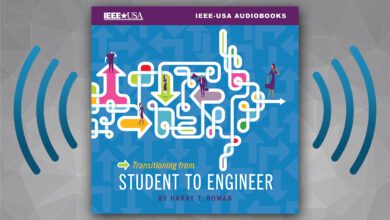
Members who eagerly snapped up the first two free audiobook volumes of Harry T. Roman’s series on Thomas Edison are in for a pre-holiday treat.
IEEE-USA is offering the third — and final — audiobook in the series, Thomas Edison: Man of the Millennium, beginning 1 November. The companion e-book from the series is also available to members at no charge.
In Volume 3, titled Observations, the author presents a strong, persuasive case for how Edison’s innovative work more than a century ago became the basis for how engineers and other technologists are meeting the needs of contemporary society. The examples include electric automobiles, integrated circuits, and the digital economy.
Roman points out that in the early 1900s, Edison pioneered the development of a new, alkaline-based battery system that people came to know as the nickel-ion storage battery. In fact, folks saw his wife, Mina, driving her personal black brougham, electric vehicle about town — and recharging it in the Edison garage, on their Glenmont property.
The author explains that Edison believed electric vehicles were an ideal city or inter-urban mode of transportation. “His philosophy was that railroads would be the long-haul transportation form and electrics would be the preferred method — instead of smelly horses and their waste products left all over the streets,” Roman says. “He also thought horses quite dangerous — well past their time in crowded cities.”
Roman calls “prophetic” Edison’s firm belief that if gasoline were the choice for fuel, people would be no better off because, like horses, gasoline would foul city air and eventually become difficult and costly to obtain.
With a nod to 21st century environmental concerns, he affirms, “How right he would be today!”
The author emphasizes that while the relatively short range of Edison’s batteries mostly limited them to travel within a city, there has been substantial improvement over the years. However, he adds that the operating range of today’s electric vehicles is still limited, when compared to those powered by gasoline.
Members and others who listen to this audiobook will be impressed by the Roman’s exhaustive research about the Edison electric battery system, and the many interesting facts he includes. For one thing, Thomas Edison and Henry Ford were good friends–despite being on opposing sides of the automobile-power issue. As proof of their friendship, Ford gave a 1922 Model T to Edison — and the vehicle still sits in Edison’s garage at Glenmont.
Another fact is that the nickel-ion storage battery that Edison developed may have been his most profitable product; it was effective in mining, railroading, marine and military applications. It is still being used today. In fact, the battery business started by the original Thomas Edison Company remained in operation after Edison’s death in 1931, and lasted well into the 1970s.
Audiobook listeners will be interested to learn that Edison’s early experiments with the light bulb contributed greatly to today’s technological achievements. Roman explains that while trying to prolong the life of his early bulb filaments, Edison and his assistants discovered the so-called “Edison Effect” — thermionic emission — in which electricity could be moved through a direct electrical wire link between elements.
“This all happened before the electron itself was discovered and understood,” the author says. “Blunder or misunderstanding, whichever you choose, Edison’s careful experiments helped both theoretical science and applied engineering make significant advances.”
In other chapters of this audiobook, Roman describes other areas where the man they called the Wizard of Menlo Park contributed to today’s technological knowledge and know-how. For example, the chapter titled “Thomas Edison – Information Geek,” describes how his deep belief in the value of information resources provided the momentum for worldwide R&D laboratories to have comprehensive libraries close at hand.
One of the most interesting chapters in this audiobook compares the lives and contributions of Thomas Edison with Benjamin Franklin — another creative giant. Both men had the same humble beginnings, were on their own at an early age and were entrepreneurs, understanding how to sell something that others wanted. Both were also heavily involved with electricity and its practical application.
Roman describes the two men as “big thinkers” who enjoyed working with others to solve problems and develop new ideas. Franklin had a key role in creating the government of the United States; while Edison showed how to take the basic principles of inventing and scientific thinking, and use them to attain achievements in corporate R&D laboratories.
IEEE Life Senior Member Harry Roman unabashedly admits that he has been a fan of Thomas Edison since childhood. Retiring from PSE&G in 2006, he has spent much of his time working at the Thomas Edison National Historic Park in West Orange, N.J., and with the Edison Innovation Foundation. Both activities enabled him to gain access to original Edison writings, artifacts and notebooks.
Roman holds 12 United States patents and has published more than 550 scientific papers, articles, monographs and books — as well as over 70 resource books, science kits and other educational products.
Along with audiobook Volumes 1 and Volume 2, audiobook Volume 3 of Thomas Edison: Man of the Millennium, in MP3 format, is available free by going to https://ieeeusa.org/shop/audiobooks/.
The companion e-books to all three audiobooks also are available free to members through the IEEE-USA Shop.
Helen Horwitz is an award-winning freelance writer who lives in Albuquerque. She was with IEEE from 1991 through 2011, the first nine as Staff Director, IEEE Corporate Communications.






